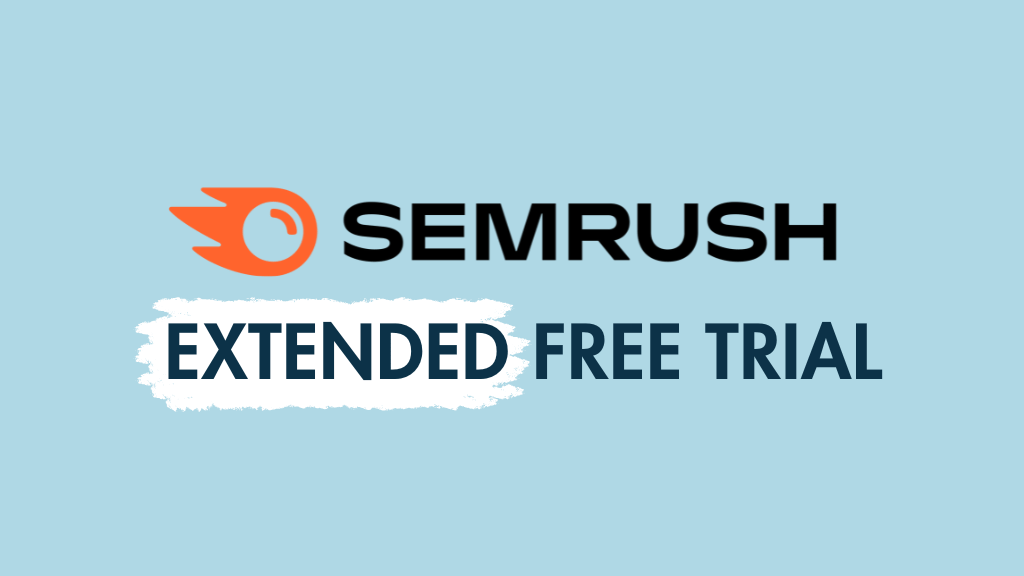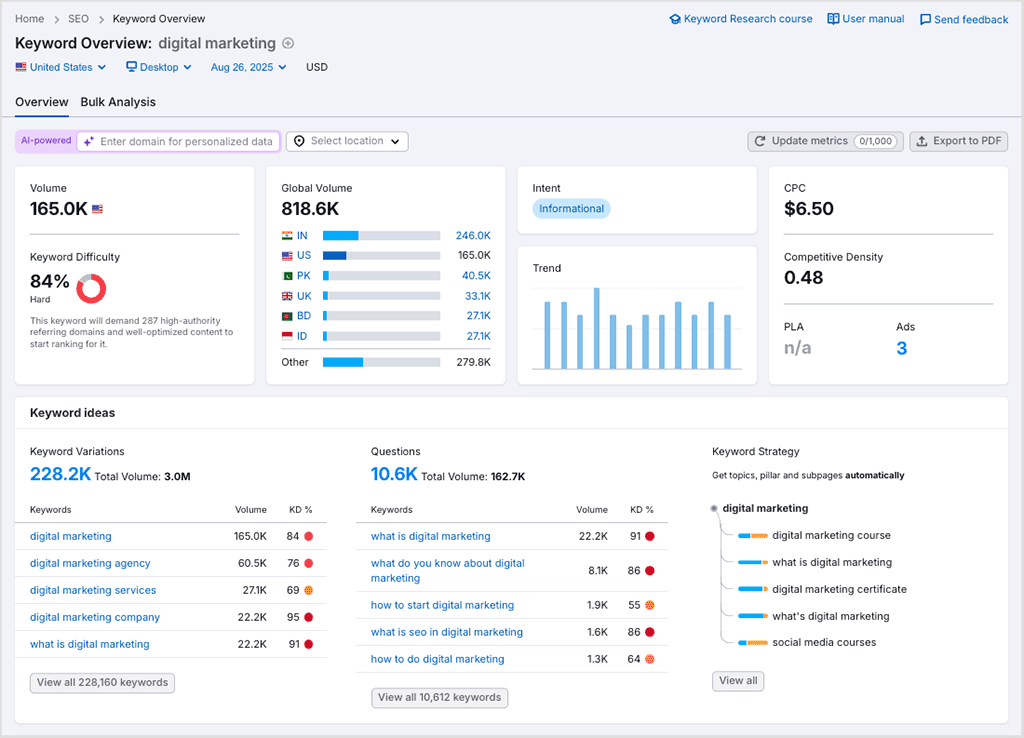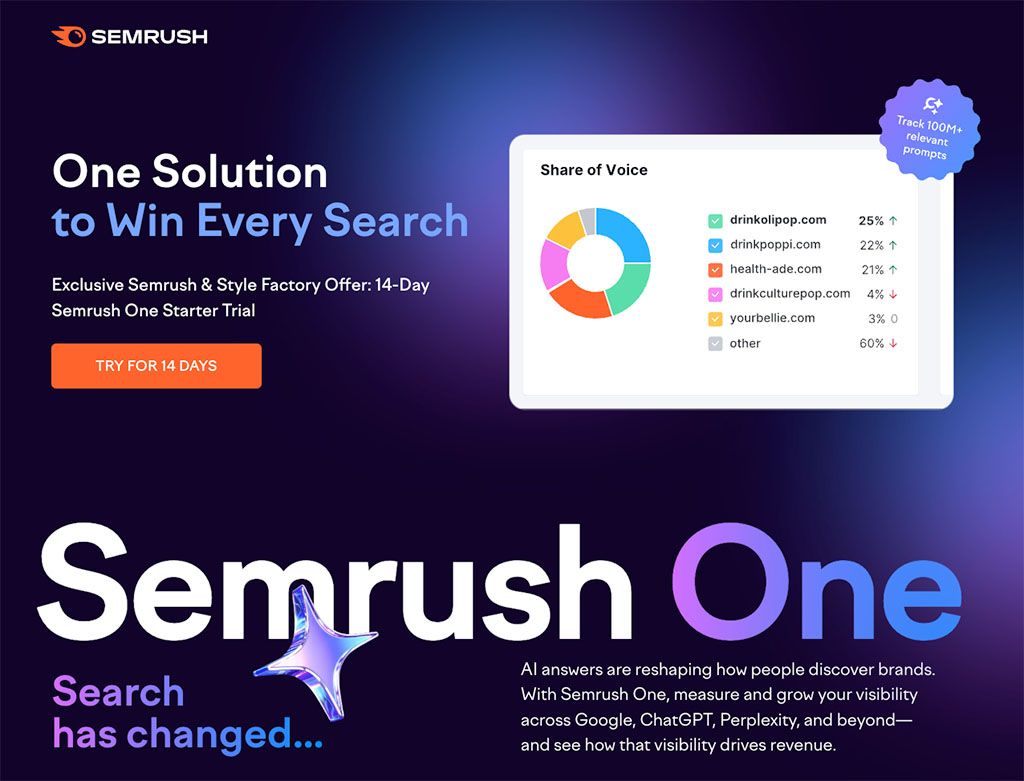We have a strict honest review policy, but please note that when you buy through our links, we may receive a commission. This is at no extra cost to you.

In this post I show you how to access a special, extended version of the Semrush free trial.
Semrush is one of the web’s leading SEO tools, providing a huge amount of information that helps you optimize your site for Google’s search engine — this includes keyword data, domain analytics, backlink analytics, site audit data and more.

However, like most other SEO tools, Semrush is not cheap — its regular plans range in price from $139.95 to $549 per month. That’s why it’s really important to make sure that you try it out fully before buying it.
To help you with this, Semrush provides you with a free trial — but normally speaking this only lasts seven days.
However, an extended version of the Semrush trial is also available via certain websites — and the good news is that Style Factory is one of these. Not just that, but we’re able to share a special trial for Semrush One — the most-fully featured version of the platform (it gives you access not just to SEO features but Semrush’s new AI Visibility Toolkit too).
If you’d like to avail of this extended Semrush One trial, as a Style Factory reader, you can do so by clicking here.
ℹ️ Note: This special trial used to last for 30 days, but recently Semrush changed their extended trial length to 14 days.
However, you can technically stretch out your trial to 21 days, by starting an extended trial via this special link, paying for your plan and then cancelling it within 7 days (if you cancel a Semrush plan within 7 days, you can avail of a refund on your plan).
Not quite the 30 days originally provided — but not bad either.
Accessing an extended Semrush Guru trial for free
As an official affiliate partner of Semrush, we’re able to offer readers another exclusive trial — a special 14 day trial of the Semrush Guru plan. This gives you entirely free access to a host of premium Semrush features, including its content market toolkit, historical data, more site auditing capabilities and much more generous reporting limits.
You’ll find more useful information about Semrush below, including some video reviews of the platform and links to comparisons with competing tools.
What is Semrush?
Semrush is primarily an SEO tool.
It lets you…
- perform keyword research
- check the authority of domains
- find backlink-building opportunities
- conduct competitor analysis
- carry out technical audits on your website.
However, Semrush also has more general marketing applications — you can also use it for crafting content and performing market research.
How long does the Semrush trial last?
Normally speaking, the Semrush trial lasts just 7 days.
However, an extended trial is available via certain websites, including Style Factory. This lasts for 14 days. You can access the extended version here.

What are the main differences between the Semrush One plans and the ‘SEO Classic’ ones?
While Semrush’s SEO Classic plans gives you access to traditional SEO tools (keyword research, rank tracking, backlink and domain analysis, site audits etc.), Semrush One plans bundle these with an additional AI Visibility Toolkit. This lets you track where your brand is appearing in AI-driven results (i.e., in LLM platforms and AI-powered search responses), measure brand presence across both traditional search and AI, benchmark competitors on those surfaces, and see what prompts are surfacing your content. In short, it lets you create and monitor campaigns that involve both traditional SEO and AI.
What are the main differences between Semrush Pro and Semrush Guru?
My table below highlights the key differences between the Semrush Pro and Semrush Guru versions of the platform.
| Feature | Semrush Pro | Semrush Guru |
|---|---|---|
| Monthly price | $139.95 | $249.95 |
| Annual price (per month) | $117.33 | $208.33 |
| Projects | 5 | 15 |
| Keywords to track | 500 | 1,500 |
| Page crawl limit (monthly) | 100,000 | 300,000 |
| AI Search tracking | ❌ Not included | ❌ Not included |
| Results per report | 10,000 | 30,000 |
| Reports per day | 3,000 | 5,000 |
| Keyword metric refreshes allowed per month | 250 | 1,000 |
| Scheduled PDF reports | 3 | 3 |
| Historical data access | ❌ Not included | ✅ Included |
| Content optimization tools | ❌ Not included | ✅ Included |
| Looker Studio integration | ❌ Not included | ✅ Included |
| Cost per additional user | $80/month | $80/month |
You can learn more about the differences between Semrush Pro and Guru here.
Do I need to submit my credit card details to avail of the Semrush free trial?
Yes, in order to use a Semrush free trial — either a 7-day one or the extended one — it is necessary to submit your credit card details.
When the trial period expires, you are automatically moved to the paid plan you have signed up for, unless you have cancelled your subscription beforehand.
What happened to the Semrush free trial that lasted 30 days?
Semrush used to give certain partner websites (including Style Factory) the option to promote a 30-day free trial of the platform. Unfortunately, this was discontinued. However, Style Factory can still offer readers an extended trial that’s double the length of the regular one — you can access this here.
Can I cancel Semrush after my free trial?
Yes, you can cancel a free Semrush trial or a paid-for Semrush plan at any time by submitting a request to do so. Cancellation will take effect at the end of a pre-paid period or, for unpaid trial or free subscriptions, within 7 days of receipt of your request by the Semrush team.
You can view Semrush’s cancellation and refund policy here.
Is there an entirely free Semrush plan available?
Yes, there is — you can access this by simply creating a Semrush account. This will let you perform some key SEO tasks with Semrush, including keyword research, link building, competitor analysis, rank tracking and site audits. However, you can only pull 10 reports per day using a free Semrush account.
So, in most cases, it’s better to start an extended Semrush free trial, because this will provide access to a lot more data, give you a better understanding of the tool, and let you switch to the entirely free version anyway (so long as you request a cancellation of the trial / paid-version).
What is the user feedback on Semrush like?
Based on user ratings on leading review sites, Semrush is generally well received by users. I’ve put together a table detailing Semrush rankings across popular review sites (see below) and as you can see, Semrush scored an average of 3.9 out of 5 on the review sites I researched.
| Site | Semrush user rating |
| Capterra | 4.6 out of 5 (2,299 reviews) |
| G2 | 4.5 out of 5(2,906 reviews) |
| Trustpilot | 2.3 out of 5 (1090 reviews) |
| TrustRadius | 4.4 out of 10 (767 reviews)* |
| Average user score (out of 5) | 3.9 |
* score originally out of 10, but recalculated as an out of 5 score for clarity
How much does Semrush cost per month?
There are two sets of Semrush plans available:
Semrush One (SEO + AI visibility tools)
- Starter: $199 per month
- Pro+: $299 per month
- Advanced: $599 per month
Semrush Classic (SEO tools only)
- Semrush Pro ($139.95 per month)
- Semrush Guru ($249.95 per month)
- Semrush Business ($499.95 per month)
- Custom (negotiable pricing based on requirements).
These monthly fees are reduced by up to 17% if you pay for your account on an annual basis.
An custom plan is also available, for which pricing is negotiable.
The main differences between the two sets of plans involves access to AI visibility tools — while Semrush One provides them, Semrush Classic doesn’t.
As for the differences between the pricing tiers within these two sets, these mainly involve reporting limits and access to content marketing tools. For a full overview of the differences, please see our guide to Semrush pricing.
(Our Semrush Pro vs Semrush Guru comparison is also of relevance here, as is our Semrush Guru free trial guide).
Additional fees also apply if you want access to extra functionality. These include Semrush’s Traffic & Market toolkit (for benchmarking your site’s traffic against competitors and spotting new markets), its Local toolkit (for managing listings, reviews, and citations to boost local SEO), its Advertising toolkit (for researching competitors’ PPC campaigns and ad strategies), and a range of paid apps from the Semrush App Center.
Is Semrush the best SEO tool?
It’s certainly one of the best — based on our testing we’ve found it to be one of the most feature-rich available. It boasts a large userbase (according to the company over 10 million people have used the product) and a client roster that includes clients like IBM, Samsung and Tesla.
If you’re interested in exploring some alternatives however, please see our SEO tool reviews section.
Is it worth paying for Semrush?
If you’re serious about search engine optimization, yes. Although there’s a free version of the platform available, it restricts your access to data to just 10 reports per day, which won’t be enough data to run professional SEO campaigns.
What are the main alternatives to Semrush?
Popular alternatives to Semrush include Ahrefs, Moz, SpyFu, Majestic, SE Ranking and Ubersuggest. We have some reviews and comparisons of some of these tools available — you may find the following posts useful:
We have some video comparisons of these alternatives available too. Below you’ll find our Ahrefs vs Semrush video comparison.
You’ll find our Ahrefs vs Moz vs Semrush shootout below:
Our SE Ranking video comparison is below:
And finally, we have a Semrush vs SpyFu video comparison:
What is Semrush’s refund policy?
Semrush provides a 7-day money-back guarantee on all plans — i.e., if you cancel your subscription within 7 days of your purchase, you’ll be entitled to a full refund.
You can view the full Semrush refund policy here.
What search engines does Semrush provide data for?
Most of Semrush’s data relates to Google only. (You can however access rank tracking data for Baidu, Bing, ChatGPT Search and Google AI Mode too.)
This focus on Google data is perhaps understandable however as at time of writing, around 90% of all searches are conducted using this search engine (source: Statcounter).
What can I do with a Semrush free account?
The free account gives you access to all of the key Semrush features, including keyword research (using the Keyword Magic tool), competitor analysis, keyword tracking, an on page SEO checker, technical site audits and social media account management. However you can only pull 10 reports per day, which makes the free trial a better option for trying out the platform.
Why is Semrush expensive?
Semrush is expensive because it’s not just an app that provides functionality — it’s effectively a sophisticated database too (containing a lot of information involving Google and your competitors). This data is costly to collect, store and keep up to date, and some of these costs are passed onto customers in the form of monthly fees.
Are there any discounts available for Semrush?
Semrush discounts its Pro, Guru and Business plans by $22.62, $41.62 and $83.29 per month respectively if you pay for your subscription on an annual basis.
Where can I learn more about Semrush?
For a full overview of Semrush, we’d recommend reading our review of the platform and our guide to its pricing structure.
Other free trials and offers from Style Factory
Update details
This article was updated on 9 December 2025. The following updates were made:
- The free trial page screenshot was updated.
- The Semrush plan comparison table was updated.
- User review scores were updated.
- Information about the new ‘Semrush One’ plan was edited.
- Free trial links were updated.
No comments